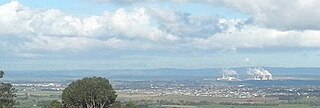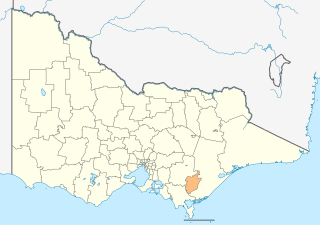
The Wilsons Promontory National Park, commonly known as Wilsons Prom or The Prom, is a national park in the Gippsland region of Victoria, Australia, located approximately 157 kilometres (98 mi) southeast of Melbourne.

Traralgon is a town located in the east of the Latrobe Valley in the Gippsland region of Victoria, Australia and the most populous city in the City of Latrobe and the region. The urban population of Traralgon at the 2021 census was 26,907. It is the largest and fastest growing city in the greater Latrobe Valley area, which has a population of 77,168 at the 2021 Census and is administered by the City of Latrobe.
The Morwell National Park is a national park located in the western Gippsland region of Victoria, Australia. The 565-hectare (1,400-acre) national park is situated approximately 164 kilometres (102 mi) east of Melbourne via the Princes Highway and 16 kilometres (9.9 mi) south of Morwell in the Strzelecki Ranges. The park preserves a remnant of previously widespread wet sclerophyll forests and some rainforest remnants restricted to deep creek gullies. 320 plant species have been recorded for this park, including five rare or threatened species and 44 orchid species. 129 native fauna species have been recorded, including 19 mammals, 96 birds, 11 reptiles and three amphibians.

The Tarra-Bulga National Park is a small national park located in the South Gippsland region of eastern Victoria, Australia approximately 240 kilometres (150 mi) south east of Melbourne. The park is located 33 kilometres (21 mi) south of Traralgon on the Traralgon-Balook Road and 24 kilometres (15 mi) north of Yarram.

Morwell is a town in the Latrobe Valley area of Gippsland, in South-Eastern Victoria, Australia approximately 152 km (94 mi) east of Melbourne.

Gippsland is a rural region that makes up the southeastern part of Victoria, Australia, mostly comprising the coastal plains to the rainward (southern) side of the Victorian Alps. It covers an elongated area of 41,556 km2 (16,045 sq mi) located further east of the Shire of Cardinia between Dandenong Ranges and Mornington Peninsula, and is bounded to the north by the mountain ranges and plateaus/highlands of the High Country, to the southwest by the Western Port Bay, to the south and east by the Bass Strait and the Tasman Sea, and to the east and northeast by the Black–Allan Line.

The Latrobe Valley is an inland geographical district and urban area of the Gippsland region in the state of Victoria, Australia. The traditional owners are the Brayakaulung of the Gunai nation. The district lies east of Melbourne and nestled between the Strzelecki Ranges to the south and the Baw Baw Ranges, part of the Great Dividing Range, to the north. Mount St Phillack is the highest peak to the north of the Latrobe Valley, due north of Moe. The highest peak to the south is Mt Tassie, south of Traralgon.

The City of Latrobe is a local government area in the Gippsland region in eastern Victoria, Australia, located in the eastern part of the state. It covers an area of 1,426 square kilometres (551 sq mi) and in June 2018 had a population of 75,211. It is primarily urban with the vast majority of its population living within the four major urban areas of Moe, Morwell, Traralgon, and Churchill, and other significant settlements in the LGA include Boolarra, Callignee, Glengarry, Jeeralang, Newborough, Toongabbie, Tyers, Yallourn North and Yinnar. It was formed in 1994 from the amalgamation of the City of Moe, City of Morwell, City of Traralgon, Shire of Traralgon, and parts of the Shire of Narracan and Shire of Rosedale. The Yallourn Works Area was added in 1996. When formed, the municipality was called the Shire of La Trobe, but on 6 April 2000, it adopted its current name.

The Strzelecki Ranges is a set of low mountain ridges located in the West Gippsland and South Gippsland regions of the Australian state of Victoria.

Moe is a town in the Latrobe Valley in the Gippsland region of Victoria, Australia. It is approximately 130 kilometres east of the central business district of Melbourne, 45 kilometres due south of the peak of Mount Baw Baw in the Great Dividing Range and features views of the Baw Baw Ranges to the north and Strzelecki Ranges to the south.

Falcons 2000 Soccer Club is an Australian semi-professional soccer club based in the regional Victorian city of Morwell in Latrobe Valley, Gippsland. The club currently participates in the Latrobe Valley Soccer League, currently rated as a Tier 9 league.

The Field Naturalists Club of Victoria (FNCV) is an Australian natural history and conservation organisation. The club is the oldest of its kind in Australia and is unique in having existed continuously since its foundation. Since its founding, the club has drawn its membership from the ranks of both amateur naturalists and professional scientists. This dual stream of members has continued into the 21st century, in which the club is well known for not only its scientific research output, but also numerous ongoing citizen science projects.

Yallourn North is a town in the City of Latrobe, Victoria, Australia. It is approximately eight kilometres north-east of Moe, and 146 kilometres south-east of Melbourne. Prior to 1947 Yallourn North was known as "Brown Coal Mine".
Bruce Alexander Fuhrer OAM was an Australian botanist and photographer, specialising in cryptogams. His photographic collection of fungi numbers more than 3000 species.

The Gippsland League is an Australian rules football and netball league in the Gippsland region of Victoria, Australia. It is considered the only AFL Victoria major league in Gippsland.
Latrobe Valley Soccer League (LVSL) is a soccer league encompassing much of Gippsland and the Latrobe Valley. The association's headquarters are based in the Morwell, Victoria (Victoria), and are affiliated under the auspices of Football Victoria (FV).
The Castlemaine Field Naturalists Club (CFNC) is an Australian regional natural history society dedicated to the study, appreciation and conservation of the natural environment in the Castlemaine region of Victoria. Founded in 1976, the CFNC has played a pivotal role in promoting environmental awareness and scientific enquiry within the Castlemaine community.

The Field Naturalists' Club of Ballarat (FNCB) is an Australian regional scientific natural history and conservation society. The club was founded in 1952 (a continuation of the Field Club and Science Society) and is located in Ballarat, Victoria.
The Bendigo Field Naturalists Club (BFNC) is an Australian regional scientific natural history society, dedicated to the study, appreciation and conservation of the natural environment. It is located in Bendigo, in central Victoria and focuses on the native biodiversity of the Bendigo Valley.















